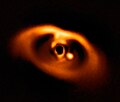Radius, mass, and temperature
TRAPPIST-1d was detected with the transit method, allowing scientists to accurately determine its radius. The planet is about 0.788 R🜨 with a small error margin of about 70 km. Transit timing variations and complex computer simulations helped accurately determine the mass of the planet, which led to scientists being able to calculate its density, surface gravity, and composition. TRAPPIST-1d is a mere 0.388 M🜨 , making it one of the least massive exoplanets yet found. [2] Initial estimates suggested that it has 61.6% the density of Earth (3.39 g/cm3) and just under half the gravity. [3] Compared to Mars, it has nearly three times that planet's mass but was thought to still be significantly less dense, which would indicate the presence of a significant atmosphere; models of the low density of TRAPPIST-1d indicated a mainly rocky composition, but with about ≤5% of its mass in the form of a volatile layer. The volatile layer of TRAPPIST-1d may consist of atmosphere, ocean, and/or ice layers. [3] However, refined estimates show that the planet is more dense, closer to 79.2% of Earth's bulk density (4.35 g/cm3 ). [2] TRAPPIST-1d has an equilibrium temperature of 282.1 K (9.0 °C; 48.1 °F), assuming an albedo of 0. [8] For an Earth-like albedo of 0.3, the planet's equilibrium temperature is around 258 K (−15 °C; 5 °F), very similar to Earth's at 255 K (−18 °C; −1 °F). [9]
Orbit
TRAPPIST-1d is a closely orbiting planet, with one full orbit taking just 4.05 days (about 97 hours) to complete. [8] It orbits at a distance of just 0.02228 AU from the host star, or about 2.2% the distance between Earth and the Sun. [3] For comparison, Mercury, the Solar System's innermost planet, takes 88 days to orbit at a distance of about 0.38 AU. The size of TRAPPIST-1 and the close orbit of TRAPPIST-1d around it means that the star as seen from the planet appears 5.5 times as large as the Sun from the Earth. While a planet at TRAPPIST-1d's distance from the Sun would be a scorched world, the low luminosity of TRAPPIST-1 means that the planet gets only 1.043 times the sunlight that Earth receives, placing it within the inner part of the conservative habitable zone. [8]
Host star
The planet orbits an (M-type) ultracool dwarf star named TRAPPIST-1. The star has a mass of 0.089 M☉ (close to the boundary between brown dwarfs and hydrogen-fusing stars) and a radius of 0.121 R☉. It has a temperature of 2,516 K (2,243 °C; 4,069 °F), and is between 3 and 8 billion years old. In comparison, the Sun is 4.6 billion years old [10] and has a temperature of 5778 K (5504.85 °C, 9940.73 °F). [11] The star is metal-rich, with a metallicity ([Fe/H]) of 0.04, or 109% the solar amount. This is particularly odd as such low-mass stars near the boundary between brown dwarfs and hydrogen-fusing stars should be expected to have considerably less metals than the Sun. Its luminosity (L☉) is 0.05% of that of the Sun.
Stars like TRAPPIST-1 have the ability to live up to 4–5 trillion years, 400–500 times longer than the Sun will live (the Sun only has about 5 billion years of lifespan left, slightly more than half of its lifetime). [12] Because of this ability to live for long periods of time, it is likely TRAPPIST-1 will be one of the last remaining stars when the Universe is much older than it is now, when the gas needed to form new stars will be exhausted, and the remaining ones begin to die off.
The star's apparent magnitude, or how bright it appears from Earth's perspective, is 18.8. Therefore, it is too dim to be seen with the naked eye (the limit for that is 6.5).
The star is not just very small and far away, it also emits comparatively little visible light, mainly shining in the invisible infrared. Even from the close in proximity of TRAPPIST-1d, about 50 times closer than Earth is from the Sun, the planet receives less than 1% the visible light Earth sees from the Sun. This would probably make the days on TRAPPIST-1d never brighter than twilight is on Earth. However, that still means that TRAPPIST-1 could easily shine at least 3000 times brighter in the sky of TRAPPIST-1d than the full moon does in Earth's night sky.





